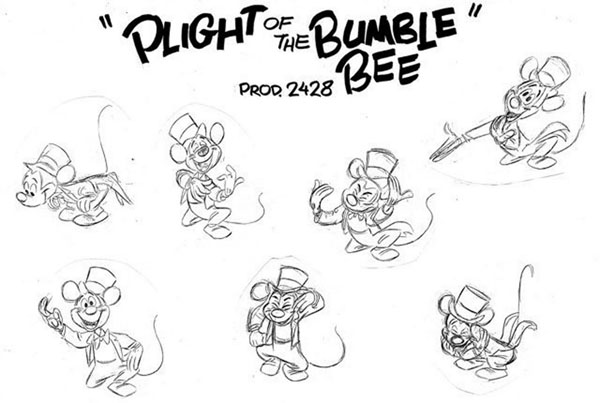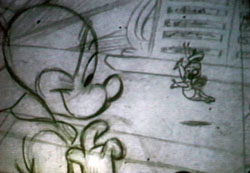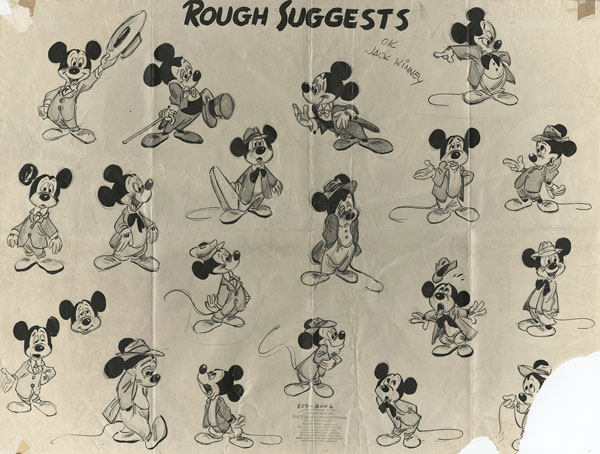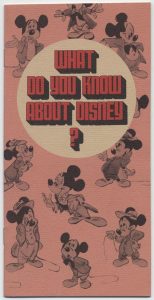Suspended Animation #230

The reason for so many unmade Mickey Mouse animated shorts was not just that a story idea didn’t seem to gel but that Mickey was the victim of his own early success.
When interviewed in a 1949 issue of Collier’s magazine, Walt stated:
“Mickey’s decline was due to his heroic nature. He grew into such a legend that we couldn’t gag around with him. He acquired as many taboos as a Western hero — no smoking, no drinking, no violence.”
Some ideas did, however, progress almost to the final production stage. For example, two unreleased Mickey Mouse shorts from 1951 were close to completion before they were abandoned.
One of them, The Talking Dog, focused more on Pluto than on Mickey, like many other Mickey shorts of the time. Pluto is kidnapped by Pete, a con man selling a fake concoction that he claims is “the medicine that takes warts off frogs, turns hiccups into teacups and guaranteed to cure the Texas tickle!” He demonstrates it to the crowd using Pluto.
Fred Moore did the animation of Mickey Mouse and Norm Ferguson worked on Pluto. Mickey must rescue his canine friend and the short climaxes with Mickey and Pete battling on top of Pete’s runaway medicine show van with Pluto trying to steer with his teeth.
 The Plight of the Bumblebee is the other nearly completed Mickey Mouse cartoon from 1951.
The Plight of the Bumblebee is the other nearly completed Mickey Mouse cartoon from 1951.
Once again, the primary Mickey Mouse animation was done by Fred Moore, with other scenes animated by Cliff Nordberg and Hal King. John Sibley may have been involved as well.
Director Jack Kinney offered his explanation why the short was abandoned before going to ink and paint:
“The best Mickey ever was never finished. It was called The Plight of the Bumble Bee, and it was all finished in animation. It had an awkward length, but Fred and Sib agreed that it could not be cut, so it was shelved.”
Most animation scholars, however, agree that length was not the major factor in the cancellation of the film.
The Plight of the Bumble Bee is not “the best Mickey ever”, but it is a nice cartoon and a little out of the ordinary for Mickey. For one thing, he is dressed in a suit and a hat (think of Mickey dressed as Don Draper from the television series Mad Men) and calls to mind the “look” of Goofy as an office worker from cartoons of the same time period. It was a more suburban look that was common in that era’s daily newspaper strips.

The film has straight voice-over narration. I asked voice expert Keith Scott whether he recognized the announcer’s voice or any of the other voices in the film:
“I think the narrator could be Wendell Niles, Ken Niles’ brother. The singer sounds a bit like the frog singer Bill Roberts in places, and the female sounds like Aileen Carlisle, but I am sure since the film was nearly completed that the Disney Archives could find the payment records from that time period to accurately identify the voices.”
Walt always said that Mickey’s voice, because of its limited range, could not sustain long stretches of dialog, so maybe that is the reason for the narration (just like in the typical suburban Goofy cartoons of the period, which were also directed by Kinney).
In the film, Mickey stumbles into a local bar, where he finds a bee named Hector singing “bebop” (a bee who is jazz bopping), but notices that the bee occasionally hits a beautiful operatic note. Mickey decides the bee is destined for bigger things, and becomes his manager by signing Hector to a contract. However, Mickey soon discovers that the reason Hector is singing in a bar is that he has a weakness for the nectar of flowers.
In fact, whenever he has a drink of nectar, he becomes a sloppy drunk. So, Mickey tries to keep Hector away from temptation. Unfortunately, for Hector’s operatic debut, the stage set is decorated with flowers and Hector overindulges, sending the female opera diva on stage into a fit and a faint. Chaos ensues. After the performance, a defeated Mickey runs across a musical grasshopper outside and decides to try again.
The premise is similar to that of other animated cartoons, like Dixieland Droopy (MGM 1954), One Froggy Evening (Warners 1955), and Finnegan’s Flea (Paramount 1958).
In 1981, Daan Jippes, who was working in the Consumer Productions division of the Disney Studio in Burbank, was browsing though some index cards in the Disney Archives when he found some information about Production 2428 (The Plight of the Bumblebee), including the location of three dusty boxes filled with stacks of animation, layouts, photographed storyboards, and x-sheets (exposure sheets). He also found the recorded soundtrack (with the final voices) on a transcription disc.
In an interview with Christopher Finch and Linda Rosenkrantz, Disney Legend Floyd Gottfredson, who did the Mickey Mouse comic strip for decades, pointed at some artwork on the wall above his drawing table and said:
“This big model sheet up here was all made from drawings that [Fred Moore] made for… a featurette, called The Plight of the Bumblebee. Mickey had a bee that could buzz operatic numbers; he was a great virtuoso that way. But the bee had a weakness, he was a nectarholic: he’d get drunk on nectar, so Mickey had trouble controlling him this way. Fred got that picture about 90% animated, I understand, and Walt dumped it because he got scared of the alcoholic connotations.”
 The “alcoholic connotations” were probably not the reason the film was dropped because during this time period drunkenness was not considered a disease but rather a weakness and often was used as a springboard for comedic moments in films.
The “alcoholic connotations” were probably not the reason the film was dropped because during this time period drunkenness was not considered a disease but rather a weakness and often was used as a springboard for comedic moments in films.
The Fred Moore model sheet was later used as the cover for a 1972 animator recruitment booklet from the Disney Studio entitled What Do You Know About Disney?
Under the supervision of animator and director Bunny Mattinson, and using all the elements that Jippes had been found, a picture reel of The Plight of the Bumble Bee was filmed and shown to Disney executives; unfortunately, Jeffrey Katzenberg (then Chairman of Walt Disney Studios) chose not to complete it.
After the screening, someone walked away with the picture reel—but fortunately, Mattinson had had the foresight to burn a one-quarter inch copy for himself. When Jippes was working on the television series Mickey MouseWorks in 1999, there was talk about finally finishing the short and using it on the series—but nothing came of it.
Perhaps the real reason for these two shorts being abandoned was Walt deciding that he couldn’t generate a good enough story that would properly showcase Mickey Mouse. He told an interviewer in 1951, the same year these shorts were abandoned:
“I’m tired of Mickey now. For him, it’s definitely trap time. The Mouse and I have been together for about 22 years. That’s long enough for any association.”
Those harsh words did not reflect Walt’s true feelings, just his frustration at being unable to find a good vehicle for Mickey.


 Jim Korkis is an internationally respected animation historian who in recent years has devoted his attention to the many worlds of Disney. He was a columnist for a variety of animation magazines. With his former writing partner, John Cawley, he authored several animation related books including The Encyclopedia of Cartoon Superstars, How to Create Animation, Cartoon Confidential and Get Animated’s Animation Art Buyer’s Guide. He taught animation classes at the Disney Institute in Florida as well as instructing classes on acting and animation history for Disney Feature Animation: Florida.
Jim Korkis is an internationally respected animation historian who in recent years has devoted his attention to the many worlds of Disney. He was a columnist for a variety of animation magazines. With his former writing partner, John Cawley, he authored several animation related books including The Encyclopedia of Cartoon Superstars, How to Create Animation, Cartoon Confidential and Get Animated’s Animation Art Buyer’s Guide. He taught animation classes at the Disney Institute in Florida as well as instructing classes on acting and animation history for Disney Feature Animation: Florida.




















































This is a terrific cartoon! Such a shame that it was never c ompleted. It definitely shows a kind of new “direction” for Mickey Mouse, with a pace that equals the kind of stuff created at Warner Brothers or, dare I say it, the kind of material we got from Tex Avery or Lah and Blair at MGM. I’m not saying that the animation styles are the same, but it certainly put Mickey in the same league as the afore-mentioned talents. Perhaps this short still has a chance of being “finished” with score and everything. Thanks for posting.
Not a bad effort at all for a late Mickey cartoon, and Fred Moore’s animation is superb as always. While Mickey is relegated to the role of straight man here, as he had been for at least a decade, at least he’s not a pathetic victim as in his final cartoon “The Simple Things” (1953), beaten into submission by a hungry seagull and a squirting clam. Even worse are some of the Famous Studios cartoons of this vintage, in which the once mighty Popeye is defeated by mice and termites. Why couldn’t heroes be heroes?
I’m sure there’s no chance of “Plight of the Bumblebee” being finished for release in this day and age, but I’m glad the animatic is still around for Disney fans to enjoy. I hope Mickey had better luck controlling his grasshopper client’s tobacco-chewing addiction.
Love this film also. Enough so, that years ago, I did some customization of the internet print to make it look more like a finished product. First, I tweaked the exposure of several shots so that it didn’t vary so much between overexposed and underexposed scenes. Then, I digitally created a color version of the title card from the B&W sketch. I modified surviving RKO titles from “R’Coon Dawg” to switch the year to 1951, and assembled a director’s card based on what staff data was verifiable mixed with other usual suspects of Kinney’s unit. (No MPAA number of course, as the film wasn’t submitted for certification.) And end card from “R’Coon Dawg” also. For music over the titles, I chose cues from “Mickey’s Delayed Date” – opening cue of which was still in use on “R’Coon Dawg” – ending cue (starting after the words “Bring the Tickets”) seeming to fit well as building to a crescendo under Mickey’s over-hopeful dialog about making the grasshopper (or was he a cricket) a success. Incidentally, maybe they should have made the fiddling discovery Pinto Colvig’s grasshopper from “The Grasshopper and the Ants” for a funnier in-joke! But one of the most surprising “perfect fits” I found among Disney music cues was the opening scene music from 1952’s “Two Chips and a Miss” – which times out perfectly to underscore the “big city” opening scene and Mickey’s trip to the pawn shop, then appropriately change cues as he approaches the entrance to the malt shop. Is it possible that this cue was originally recorded with intent for use of same on this film? It might account for the odd and prolonged timing of the night club montage on “Two Chips” if Hannah had to time the scene to match an already-recorded cue produced for another purpose. One final note I thought odd was why the titling department’s sketch chose to use Hannah’s Spike the Bee instead of a more rotund design resembling Hector. Anyway, great stuff. Disney should have loosened up and let this bee “fly”.
It seems that the problem was with Walt at this point. The film didn’t need narration. That sounds like an idea that Disney stuck them with. Fred Moore’s acting is incredible. The whole cartoon could have been done with minimal or no dialogue. This is almost like having another “One Froggy Evening.” I think Walt would have rejected that film as well.
It sounds like Walt was becoming out of touch with simple one reel cartoons, and for whatever personal reasons was rejecting excellent material.
From what I can remember from Korkis’ Mickey book (unless it was another source), the producers thought the film was a bit long for some reason, but the staff didn’t think there was anything that could be drop from it and the producers agreed and decided to have the film shelved.
Also, according to the recent coffee table book, the studio at the time had numerous focus groups to review which upcoming planned film would test well enough to be released. Sometimes, the same film that tested well in a previous session would not have the same result in a later one. Of course, these types of sessions are a mixed bag and don’t really reflect the actual going audience and the results aren’t always correct. I’m guessing this short might also have been a victim of this rather flawed system.
John Sibley was definitely involved with this. He animated most of the operatic scenes (including Mickey’s reactions). Top notch as usual. And that’s definitely Fred Moore handling Mickey throughout most of the other scenes (ie. him training the bee, etc.). This would have made a great cartoon for the public to see. Jack Kinney’s involvement certainly helps. I keep trying to hear this cartoon with Oliver Wallace’s music in my mind.
Both the construction worker in “One Froggy Evening” and the frozen-in-place Finnegan in Paramount’s effort are pegged as sympathetic, but hopeless losers by the end of those cartoons. Which may not have been way Walt wanted to see Mickey framed here — personality-wise, that role was more suited for Donald, in seeking to make a buck off a novelty act but having the whole thing blow up in his face (but then you’d be doing a duck cartoon without Clarence Nash’s voice, or you’d have to change that aspect of the story).
When you wrote “After the screening, someone walked away with the picture reel—but fortunately, Mattinson had had the foresight to burn a one-quarter inch copy for himself”, what did you mean by “one-quarter inch copy”?
Fred Morton
Oklahoma City
That would be a 1/4-inch video tape copy.
Beautifully animated but the whole narration approach is just wrong.
Narration works for the Goofy cartoons of the period because they’re take-offs on instructional videos. But this is a story. Narration puts the viewer at a remove from the action; past tense narration puts the viewer at 2 removes from the action.
And making Mickey’s interior voice so different from his known, famous voice puts the viewer at an even farther remove from the action.
It would be much funnier and more immediate if it unfolded like a standard cartoon, with dialogue and action driving the story, rather than narration. But that’s just this fan’s opinion.
It would have been interesting to see how it would work without narration. Actually, it would probably feel a lot like the Bill Walsh-scripted Floyd Gottfredson newspaper strips of the era, where Mickey was often a straight man finding himself in strange or absurd scenarios.
“When Jippes was working on the television series Mickey MouseWorks in 1999, there was talk about finally finishing the short and using it on the series—but nothing came of it.”
That’s interesting, but I can’t imagine how this short would have fit with the style and tone of the 1999 MouseWorks series (or the subsequent House of Mouse). Not exactly surprising that nothing happened.
I will always be a huge Mickey Mouse fan, however there are times that I feel that the final decision on the sound of Mickeys voice in cartoons back to the very beginning could have been tweaked, or just different altogether. I still love all the shorts, don’t get me wrong, but I do feel that Mickey had been painted into a corner in both sound, and behavior and just being the good boy Disney mascot.
However when I discovered Floyd Gottfredson’s comic strip work in 1983 when I was 13, I fell head over heels in love. THIS was the Mickey I wanted to see in cartoon shorts. Adventurous, Mischievous……Mickey’s dialogue in the strips was also a bit hard to project into the actual voice from the cartoon shorts making me wonder how is voice would actually sound in the strip.
I find it interesting that the comic strip could continue with such an interesting version of Mickey but the animation department found the character almost impossible to use by the late 30’s. I suspect Walt was the problem, not the animation story department.
Not long ago a GIF of some of Freddie’s animation from this short appeared on my Twitter feed and I wondered where it was from. I would have loved this cartoon to be at least included on a DVD as an extra. I’m also intrigued about the other cartoon idea mentioned, “The Talking Dog”. Mickey looking for Pluto and fighting Pete would have made for a more proactive version of the character than his other appearances at the time, more akin to his early thirties heyday (though the fight on a runaway wagon might have been too expensive for a short). Incidentally, anyone know what the “Texas Tickle” refers to?
“…though the fight on a runaway wagon might have been too expensive for a short…”
I doubt that, as the animation for “The Talking Dog” was virtually finished, akin to “Plight of the Bumble Bee”. I wish they had re-assembled this short too like they did with “Plight” in the 80s, then maybe we could at least get to see in in pencil animation.
I believe the “Texas tickle” is a kind of heat rash. However, the online Urban Dictionary defines it as several varieties of perverted sex acts, and I’m sure that’s NOT what Pete meant!
I LIKE IT. I’ve never heard of this one before. It’s pretty fascinating to see the pencil sketch version. Would it have been wonderful as a finished product? I guess we’ll never know. But this is a remarkable glimpse into the creative process. THANK YOU for sharing it.
It certainly wouldn’t have been “the best Mickey ever”, as Jack Kinney claimed. You can point to any number of Mickey cartoons from the 30s (and even late 20s) for better entries. But I too would have liked to see the finished cartoon.
The pose of Mickey tipping his hat was used on the front cover of a small blue Disneyland Records. This little booklet was placed inside album jackets in the around 1970. The back cover had a detachable survey card to be mailed back prepaid. Millions of these were distributed inside record covers and read-alongs, as well as regular white reply cards with survey questions about Disneyland Records.
Kind of wish Walt Disney Studios Animation would’ve finished it as a 90th anniversary project for the mouse
So do I. It’d’ve been cool to see it all digitally cleaned up and colored, and the story sketches fully animated by the same people who did the 2D animated films of the ’80s to present day.
I’ve often thought that the term “Drunk Mickey” would apply to Plight Of The Bumble Bee more than The Little Whirlwind or The Nifty Nineties. In this one, Mickey hangs out in, for all intents and purposes, a BAR!
Interesting reading the later story of the non-production of the film. However, in lieu of footnotes, a bit of proper attribution would have been nice: the Kinney quote, written by Kinney in a letter to my mentor, the late Børge Ring, I published on my blog in 2007: https://afilmla.blogspot.com/search?q=plight
Thank you for replying Hans!
“Those harsh words did not reflect Walt’s true feelings, just his frustration at being unable to find a good vehicle for Mickey.”
I’m not so sure of that. 😉 Walt Disney in 1951 was preoccupied with a hundred thousand other things than Mickey Mouse, or short cartoons at all. I doubt he spent much (if any) time thinking up concepts or vehicles for Mickey Mouse cartoons at that point.
Maybe it’s not too late for the team who made GET A HORSE! and the team behind The Disney Channel’s MICKEY MOUSE shorts to see who can do a better job of finishing it.
Just saying…